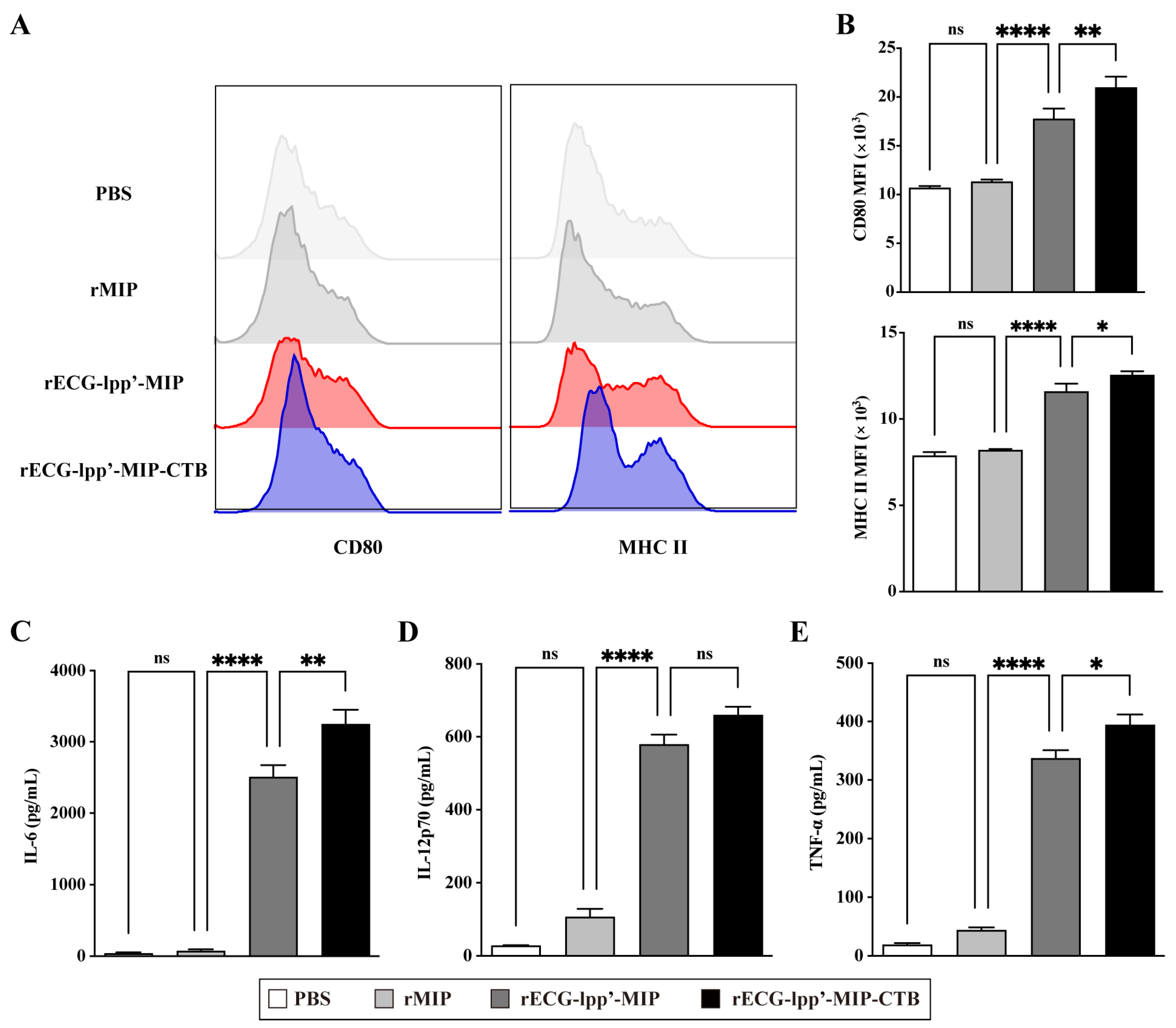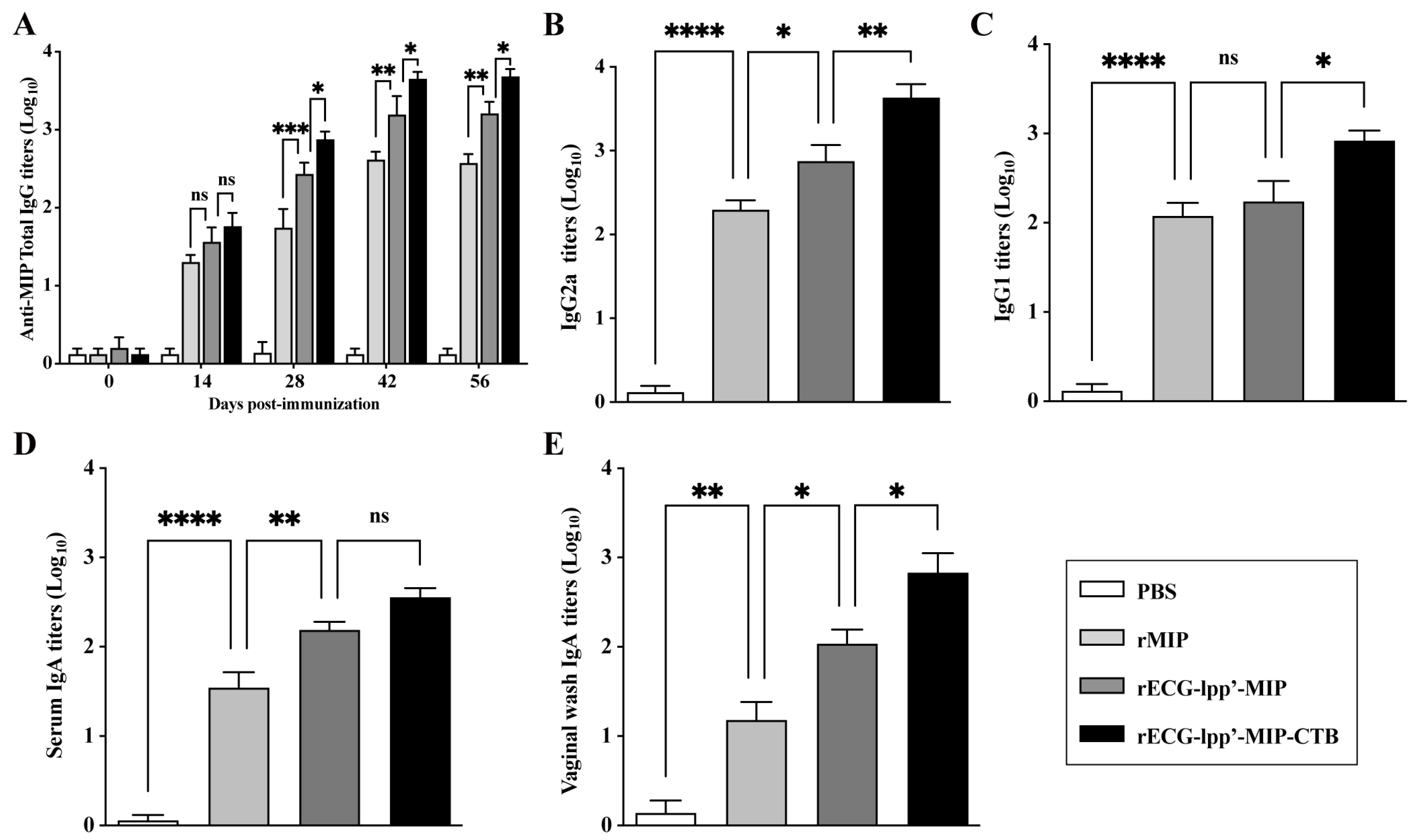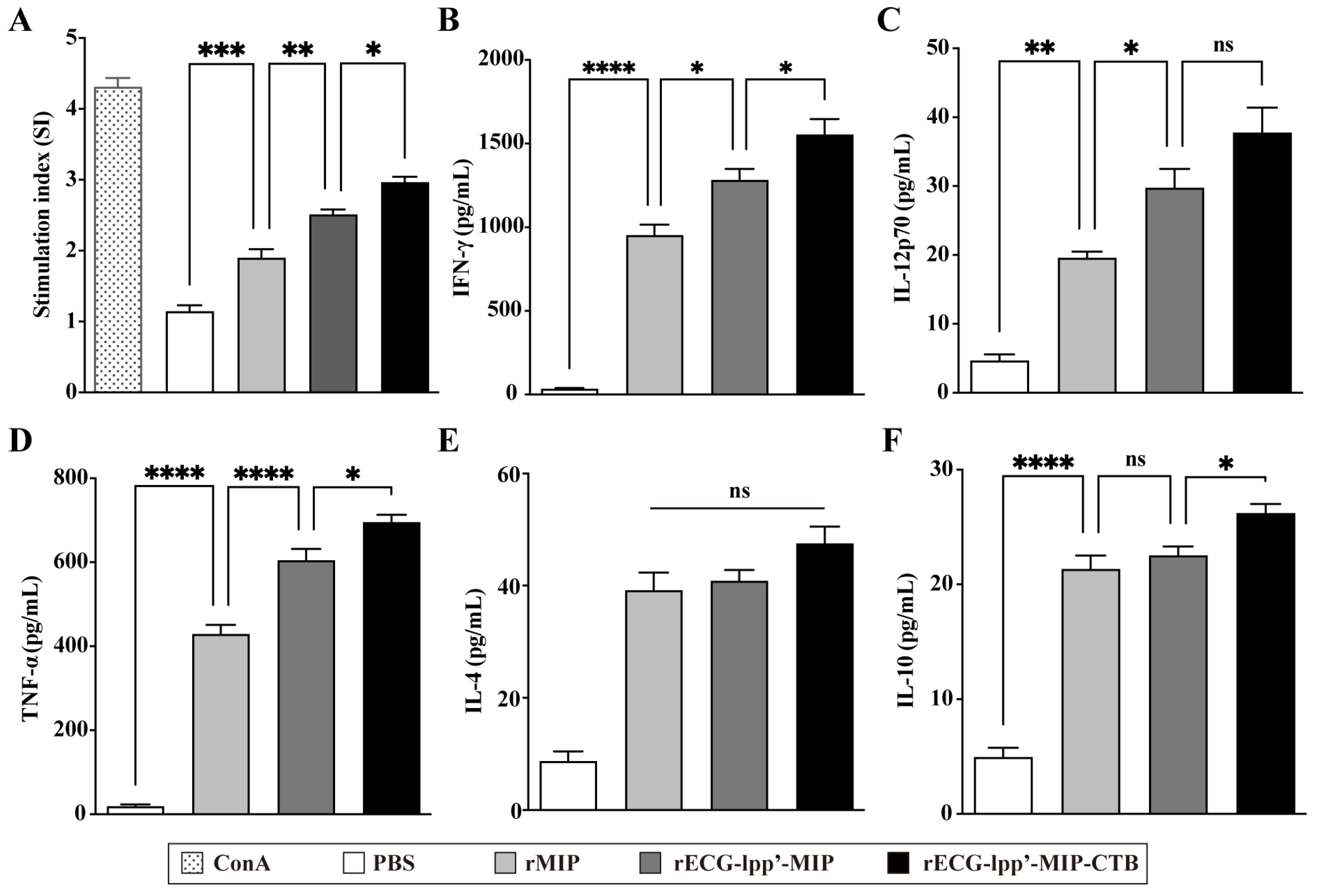Surface Display of Cholera Toxin B Subunit Recombinant Escherichia coli Ghosts Further Enhances Resistance to Chlamydia abortus Infection in Mice
Abstract
:1. Introduction
2. Materials and Methods
2.1. Animals, Cells, Plasmids, and Strains
2.2. Plasmid Construction and Induced Expression of Recombinant Protein
2.3. Western Blot
2.4. Flow Cytometry and Confocal Laser Scanning Microscopy Analyses
2.5. Preparation and Antigen Quantification of rECGs
2.6. BMDC Activation Assay
2.7. Immunization and Challenge
2.8. Spleen Lymphocyte Proliferation Test
2.9. Antibody and Cytokine Testing
2.10. Histopathology
2.11. Isolation of C. abortus from the Uterus
2.12. Statistical Analysis
3. Results
3.1. Construction of Surface-Displayed Foreign Antigen Plasmids
3.2. Detection of Fusion Protein Surface Display
3.3. Preparation of rECGs
3.4. Effect of rECGs on the Maturation and Activation of BMDCs
3.5. rECGs Induce Specific Antibody Responses in Mice
3.6. Cell-Mediated Immune Response
3.7. Protective Efficacy of rECGs
4. Discussion
5. Conclusions
Author Contributions
Funding
Data Availability Statement
Conflicts of Interest
References
- Elwell, C.; Mirrashidi, K.; Engel, J. Chlamydia Cell Biology and Pathogenesis. Nat. Rev. Microbiol. 2016, 14, 385–400. [Google Scholar] [CrossRef]
- Liang, L.; Liu, D.; Li, Z.; Zhou, J.; Tong, D. Chlamydia abortus OmcB Protein Is Essential for Adhesion to Host Cells. J. Basic Microbiol. 2021, 61, 1145–1152. [Google Scholar] [CrossRef]
- Zhang, H.; Zhang, Z.; Li, Y.; Li, W.; Jin, Y.; Li, Z.; Zhou, J.; Tong, D. Seroprevalence of Chlamydia abortus and Brucella spp. and Risk Factors for Chlamydia abortus in Pigs from China. Acta Trop. 2023, 248, 107050. [Google Scholar] [CrossRef]
- Essig, A.; Longbottom, D. Chlamydia abortus: New Aspects of Infectious Abortion in Sheep and Potential Risk for Pregnant Women. Curr. Clin. Microbiol. Rep. 2015, 2, 22–34. [Google Scholar] [CrossRef]
- Longbottom, D.; Sait, M.; Livingstone, M.; Laroucau, K.; Sachse, K.; Harris, S.R.; Thomson, N.R.; Seth-Smith, H.M.B. Genomic Evidence That the Live Chlamydia abortus Vaccine Strain 1B Is Not Attenuated and Has the Potential to Cause Disease. Vaccine 2018, 36, 3593–3598. [Google Scholar] [CrossRef]
- Livingstone, M.; Wattegedera, S.R.; Palarea-Albaladejo, J.; Aitchison, K.; Corbett, C.; Sait, M.; Wilson, K.; Chianini, F.; Rocchi, M.S.; Wheelhouse, N.; et al. Efficacy of Two Chlamydia abortus Subcellular Vaccines in a Pregnant Ewe Challenge Model for Ovine Enzootic Abortion. Vaccines 2021, 9, 898. [Google Scholar] [CrossRef] [PubMed]
- Amara, A.A.; Salem-Bekhit, M.M.; Alanazi, F.K. Sponge-like: A New Protocol for Preparing Bacterial Ghosts. Sci. World J. 2013, 2013, 545741. [Google Scholar] [CrossRef]
- Zhang, H.; Li, Z.; Li, W.; Jin, Y.; Li, Y.; Xiao, Q.; Tong, D.; Zhou, J. Comparison of the Immune Effects of the Chlamydia abortus MOMP Antigen Displayed in Different Parts of Bacterial Ghosts. Front. Microbiol. 2024, 15, 1349746. [Google Scholar] [CrossRef] [PubMed]
- Mancini, F.; Rossi, O.; Necchi, F.; Micoli, F. OMV Vaccines and the Role of TLR Agonists in Immune Response. Int. J. Mol. Sci. 2020, 21, 4416. [Google Scholar] [CrossRef]
- Senevirathne, A.; Hewawaduge, C.; Lee, J.H. Immunization of Chicken with Flagellin Adjuvanted Salmonella enteritidis Bacterial Ghosts Confers Complete Protection against Chicken Salmonellosis. Poult. Sci. 2021, 100, 101205. [Google Scholar] [CrossRef]
- Poston, T.B.; Darville, T. Chlamydia trachomatis: Protective Adaptive Responses and Prospects for a Vaccine. Curr. Top. Microbiol. Immunol. 2018, 412, 217–237. [Google Scholar] [CrossRef] [PubMed]
- Singh, S.R.; Hulett, K.; Pillai, S.R.; Dennis, V.A.; Oh, M.K.; Scissum-Gunn, K. Mucosal Immunization with Recombinant MOMP Genetically Linked with Modified Cholera Toxin Confers Protection against Chlamydia trachomatis Infection. Vaccine 2006, 24, 1213–1224. [Google Scholar] [CrossRef]
- Ekong, E.E.; Okenu, D.N.; Mania-Pramanik, J.; He, Q.; Igietseme, J.U.; Ananaba, G.A.; Lyn, D.; Black, C.; Eko, F.O. A Vibrio cholerae Ghost-Based Subunit Vaccine Induces Cross-Protective Chlamydial Immunity That Is Enhanced by CTA2B, the Nontoxic Derivative of Cholera Toxin. FEMS Immunol. Med. Microbiol. 2009, 55, 280–291. [Google Scholar] [CrossRef]
- Matoba, N.; Geyer, B.C.; Kilbourne, J.; Alfsen, A.; Bomsel, M.; Mor, T.S. Humoral Immune Responses by Prime-Boost Heterologous Route Immunizations with CTB-MPR(649-684), a Mucosal Subunit HIV/AIDS Vaccine Candidate. Vaccine 2006, 24, 5047–5055. [Google Scholar] [CrossRef]
- Ali, K.; Ali Mohammad, L.; Samaneh, K. Comparison of the Organophosphorus Hydrolase Surface Display Using InaVN and Lpp-OmpA Systems in Escherichia coli. J. Microbiol. Biotechnol. 2014, 24, 379–385. [Google Scholar] [CrossRef]
- O’Neill, L.M.; Keane, O.M.; Ross, P.J.; Nally, J.E.; Seshu, J.; Markey, B. Evaluation of Protective and Immune Responses Following Vaccination with Recombinant MIP and CPAF from Chlamydia abortus as Novel Vaccines for Enzootic Abortion of Ewes. Vaccine 2019, 37, 5428–5438. [Google Scholar] [CrossRef] [PubMed]
- Li, Z.; Cao, X.; Fu, B.; Chao, Y.; Cai, J.; Zhou, J. Identification and Characterization of Chlamydia abortus Isolates from Yaks in Qinghai, China. Biomed. Res. Int. 2015, 2015, 658519. [Google Scholar] [CrossRef]
- Matoba, N.; Magérus, A.; Geyer, B.C.; Zhang, Y.; Muralidharan, M.; Alfsen, A.; Arntzen, C.J.; Bomsel, M.; Mor, T.S. A Mucosally Targeted Subunit Vaccine Candidate Eliciting HIV-1 Transcytosis-Blocking Abs. Proc. Natl. Acad. Sci. USA 2004, 101, 13584–13589. [Google Scholar] [CrossRef]
- Paßlick, D.; Piradashvili, K.; Bamberger, D.; Li, M.; Jiang, S.; Strand, D.; R Wich, P.; Landfester, K.; Bros, M.; Grabbe, S.; et al. Delivering All in One: Antigen-Nanocapsule Loaded with Dual Adjuvant Yields Superadditive Effects by DC-Directed T Cell Stimulation. J. Control Release 2018, 289, 23–34. [Google Scholar] [CrossRef]
- Eko, F.O.; Ekong, E.; He, Q.; Black, C.M.; Igietseme, J.U. Induction of Immune Memory by a Multisubunit Chlamydial Vaccine. Vaccine 2011, 29, 1472–1480. [Google Scholar] [CrossRef]
- Ren, X.; Qian, P.; Hu, Z.; Chen, H.; Li, X. Genetic Characterization of Atypical Porcine Pestivirus from Neonatal Piglets with Congenital Tremor in Hubei Province, China. Virol. J. 2022, 19, 51. [Google Scholar] [CrossRef] [PubMed]
- Tifrea, D.F.; Pal, S.; le Bon, C.; Cocco, M.J.; Zoonens, M.; de la Maza, L.M. Improved Protection against Chlamydia muridarum Using the Native Major Outer Membrane Protein Trapped in Resiquimod-Carrying Amphipols and Effects in Protection with Addition of a Th1 (CpG-1826) and a Th2 (Montanide ISA 720) Adjuvant. Vaccine 2020, 38, 4412–4422. [Google Scholar] [CrossRef] [PubMed]
- Eko, F.O.; He, Q.; Brown, T.; McMillan, L.; Ifere, G.O.; Ananaba, G.A.; Lyn, D.; Lubitz, W.; Kellar, K.L.; Black, C.M.; et al. A Novel Recombinant Multisubunit Vaccine against Chlamydia. J. Immunol. 2004, 173, 3375–3382. [Google Scholar] [CrossRef]
- Eko, F.O.; Lubitz, W.; McMillan, L.; Ramey, K.; Moore, T.T.; Ananaba, G.A.; Lyn, D.; Black, C.M.; Igietseme, J.U. Recombinant Vibrio cholerae Ghosts as a Delivery Vehicle for Vaccinating against Chlamydia trachomatis. Vaccine 2003, 21, 1694–1703. [Google Scholar] [CrossRef] [PubMed]
- Richardson, S.; Medhavi, F.; Tanner, T.; Lundy, S.; Omosun, Y.; Igietseme, J.U.; Carroll, D.; Eko, F.O. Cellular Basis for the Enhanced Efficacy of the Fms-Like Tyrosine Kinase 3 Ligand (FL) Adjuvanted VCG-Based Chlamydia abortus Vaccine. Front. Immunol. 2021, 12, 698737. [Google Scholar] [CrossRef] [PubMed]
- Eko, F.O.; Mania-Pramanik, J.; Pais, R.; Pan, Q.; Okenu, D.M.N.; Johnson, A.; Ibegbu, C.; He, C.; He, Q.; Russell, R.; et al. Vibrio cholerae Ghosts (VCG) Exert Immunomodulatory Effect on Dendritic Cells for Enhanced Antigen Presentation and Induction of Protective Immunity. BMC Immunol. 2014, 15, 584. [Google Scholar] [CrossRef] [PubMed]
- Hajam, I.A.; Kim, J.H.; Lee, J.H. Incorporation of Membrane-Anchored Flagellin into Salmonella Gallinarum Bacterial Ghosts Induces Early Immune Responses and Protection against Fowl Typhoid in Young Layer Chickens. Vet. Immunol. Immunopathol. 2018, 199, 61–69. [Google Scholar] [CrossRef] [PubMed]
- Hsieh, M.; Chen, M.; Hsu, C.; Tsai, Y.; Chiu, F.; Hsu, C.; Lin, C.; Wu, C.; Tu, L.; Chiang, C.; et al. Recombinant Lipidated FLIPr Effectively Enhances Mucosal and Systemic Immune Responses for Various Vaccine Types. NPJ Vaccines 2023, 8, 82. [Google Scholar] [CrossRef]
- Eko, F.O.; Okenu, D.N.; Singh, U.P.; He, Q.; Black, C.; Igietseme, J.U. Evaluation of a Broadly Protective Chlamydia-Cholera Combination Vaccine Candidate. Vaccine 2011, 29, 3802–3810. [Google Scholar] [CrossRef]
- Pal, S.; Luke, C.J.; Barbour, A.G.; Peterson, E.M.; de la Maza, L.M. Immunization with the Chlamydia trachomatis Major Outer Membrane Protein, Using the Outer Surface Protein A of Borrelia Burgdorferi as an Adjuvant, Can Induce Protection against a Chlamydial Genital Challenge. Vaccine 2003, 21, 1455–1465. [Google Scholar] [CrossRef]
- Sun, J.-B.; Raghavan, S.; Sjöling, A.; Lundin, S.; Holmgren, J. Oral Tolerance Induction with Antigen Conjugated to Cholera Toxin B Subunit Generates Both Foxp3+CD25+ and Foxp3-CD25- CD4+ Regulatory T Cells. J. Immunol. 2006, 177, 7634–7644. [Google Scholar] [CrossRef] [PubMed]
- Brunham, R.C.; Rey-Ladino, J. Immunology of Chlamydia Infection: Implications for a Chlamydia trachomatis Vaccine. Nat. Rev. Immunol. 2005, 5, 149–161. [Google Scholar] [CrossRef] [PubMed]






| Primer Name | Primer Sequence (5′–3′) | Restriction Site |
|---|---|---|
| MIP-F | ACT GGATCC GATCAGAGCAGCCATAACGA | BamH I |
| MIP-R | ATT GTCGAC GCTCGCGGTGTTTTTATCT | Sal I |
| lpp-F | ACT CCATGG AAGCTACTAAACTGGTA | Nco I |
| lpp-R | ACT GGATCC CTTGTCATCGTCGTCCTTGTA | BamH I |
| CTB-F | ATA GTCGAC ACCCCGCAGAATATCAC | Sal I |
| CTB-R | ATT GCGGCCGC TTAGTTCGCCATGCTAAT | Not I |
| Vaccine | MIP (μg/mL) | Total Protein (μg/mL) | MIP/Total Protein (μg/mg) |
|---|---|---|---|
| rECG-lpp’-MIP | 61.49 | 5037.88 | 12.21 |
| rECG-lpp’-MIP-CTB | 60.69 | 5108.64 | 12.28 |
Disclaimer/Publisher’s Note: The statements, opinions and data contained in all publications are solely those of the individual author(s) and contributor(s) and not of MDPI and/or the editor(s). MDPI and/or the editor(s) disclaim responsibility for any injury to people or property resulting from any ideas, methods, instructions or products referred to in the content. |
© 2024 by the authors. Licensee MDPI, Basel, Switzerland. This article is an open access article distributed under the terms and conditions of the Creative Commons Attribution (CC BY) license (https://creativecommons.org/licenses/by/4.0/).
Share and Cite
Zhang, H.; Li, Y.; Li, W.; Li, Z.; Zhou, J.; Tong, D. Surface Display of Cholera Toxin B Subunit Recombinant Escherichia coli Ghosts Further Enhances Resistance to Chlamydia abortus Infection in Mice. Microorganisms 2024, 12, 1656. https://doi.org/10.3390/microorganisms12081656
Zhang H, Li Y, Li W, Li Z, Zhou J, Tong D. Surface Display of Cholera Toxin B Subunit Recombinant Escherichia coli Ghosts Further Enhances Resistance to Chlamydia abortus Infection in Mice. Microorganisms. 2024; 12(8):1656. https://doi.org/10.3390/microorganisms12081656
Chicago/Turabian StyleZhang, Huaiyu, Yunhui Li, Wei Li, Zhaocai Li, Jizhang Zhou, and Dewen Tong. 2024. "Surface Display of Cholera Toxin B Subunit Recombinant Escherichia coli Ghosts Further Enhances Resistance to Chlamydia abortus Infection in Mice" Microorganisms 12, no. 8: 1656. https://doi.org/10.3390/microorganisms12081656




